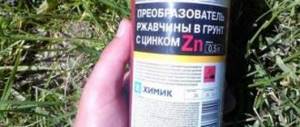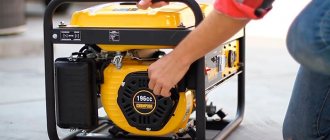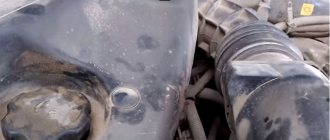Aluminum is a fairly light and durable metal, and therefore is often used in the kitchen as the main material from which cookware is made. When plaque appears, it becomes unpleasant to cook in it, and it is impossible for safety reasons, and therefore the question arises of how to clean aluminum until it shines.
- Cleaning features, general recommendations
- Cleaning aluminum cookware
- Remove carbon deposits
- Remove corrosion and oxide
- Cream of tartar
- Table vinegar
- Soap solution
- Baking soda
- Glue and soda
- Recommendations and care tips
Cleaning features, general recommendations
Heating of aluminum cookware occurs evenly and does not require much time. After some time, carbon deposits begin to appear on aluminum cookware and traces of oxide become noticeable. Most often, they try to clean aluminum using dishwashing detergent, but it can only remove external dirt and grease.
Dishes made from this material should only be washed cold, since they can easily be damaged when hot. If a hot metal is immersed in cold water, it will become deformed, and therefore you should try to avoid such a failure.
You should not try to clean burnt food immediately using iron sponges and other objects. To make the task easier, you just need to pour warm water and wait about half an hour. During this time, the food will get wet and can be removed using a regular dishwashing sponge.
It is not recommended to wash aluminum cookware in the dishwasher, since the dishwasher uses hot water during the washing process, which can damage the material. To avoid deformation, it is recommended to wash aluminum cookware by hand with warm water.
You should not use strong acids in the process, as they will not be able to restore the shine of the dishes, and may harm them. It is also not recommended to clean it with metal sponges, which leave scratches on the dishes.
What not to clean with vinegar
But there are things and objects that are “afraid” of vinegar.
After all, in fact, vinegar is an acid, which, unfortunately, does not affect all materials equally well.
Vinegar promotes oxidative processes in many substances, some of which it can even completely dissolve.
When it comes to limescale, for example, this ability of vinegar is undoubtedly welcome. However, you need to be very careful with certain materials, as you may simply harm it.
Remember that acid can be destructive, so we strongly recommend that you do not clean the following items with table vinegar.
Cleaning aluminum cookware
The main disadvantage of aluminum is its softness. It is very easy to damage and also leave scratches on it. Even with frequent washing with a melamine sponge, the surface will soon begin to become matte, as a large number of micro-scratches will remain on it.
- To restore shine, you need to use borax, ammonia and GOI paste. The latter needs to thoroughly rub the aluminum, and then, using a rag soaked in solvent, thoroughly rub the cutlery.
- Aluminum cookware can be cleaned with such products as soap, ammonia, table vinegar and table salt.
- Soot, oxide and other contaminants that accumulate on aluminum cookware can be easily removed using soft foam sponges or polymer bristles, microfiber or cotton cloths, and rags. It is necessary to ensure that they do not contain rougher and harder materials that can leave scratches.
- A good aluminum cleaner is a special product designed for cleaning glass or porcelain. They do an excellent job, gently removing dirt and adding shine to the dishes.
Choice of product
The disadvantages of aluminum include the softness of the metal and its instability to abrasive influences. If you plan to keep your pans shiny for longer, avoid using wire wool, brushes, abrasive sponges, or sandpaper.
Even the use of a melamine sponge, which can rid the metal of the oxidation film, will affect the appearance of the utensils - the shiny surface will become dull due to numerous micro-scratches.
Polishing with GOI paste will help return it to ideal condition - rub a rag soaked in a solvent with a piece of hard paste, and then polish the metal surface to a mirror shine.
When choosing how to clean aluminum, you should pay attention to substances that are almost always at hand for any housewife. These include:
- laundry soap;
- baking soda;
- salt;
- table vinegar;
- lemon juice or citric acid;
- dairy products;
- cream of tartar;
- office glue;
- oxalic acid, etc.
When cleaning aluminum utensils from blackness, stains and carbon film, use brushes with semi-rigid polymer bristles, foam sponges, cotton or microfiber napkins, and rags.
If advice on how to clean a burnt pot or frying pan at home does not help you cope with the task, you can try using special products for cleaning porcelain and glass. Or resort to such means as “Chister”, “Bagi Shumanit”, “Oven Cleaner”, etc. Use special equipment according to the manufacturer's instructions.
New aluminum utensils shine attractively, but after some time of regular use they become dull and become covered with unsightly stains. Usually, housewives use the same usual composition for washing aluminum dishes as for pots and pans made of other materials, primarily stainless steel.
But this is the wrong approach. Conventional dishwashing detergents can clean the aluminum surface of ordinary contaminants, but they will not save you from oxidation and will not be able to completely protect you from the gradual formation of plaque, which, under regular exposure to high temperatures, turns into carbon deposits over time.
Read also: Do-it-yourself band saw for wood, drawings
Therefore, as necessary, including if food is accidentally burnt during cooking, effective cleaning methods for aluminum cookware should be used, using homemade or special products.
Remove carbon deposits
Cleaning oxides and carbon deposits is also quite simple. This will require funds and products that many people have in their homes. Moreover, such cleaning does not take much time and does not require serious effort.
- Aluminum is clarified using brine from cucumbers, fermented milk products such as milk and kefir. It is necessary to pour the available product into the dishes that need to be cleaned for half a day. Most often they leave it overnight so that you can simply wash the dishes in the morning. If you need to clean some objects from carbon deposits, they can be placed at the bottom of the container that was filled. Cleansing occurs thanks to the acids found in these products.
- A sour apple will help clear carbon deposits and remove oxidation. The fruit needs to be cut in half and rubbed onto the desired surface until shiny. The acid will corrode all dirt, and therefore, after rinsing with water, the item will shine.
- Contaminants can be removed using a saline solution. You need to take salt and water in equal proportions, and the first ingredient should be completely dissolved. Using a sponge, you need to apply the solution to the item that requires cleaning, leave it in this state for a while, and then rinse thoroughly with water.
Remove corrosion and oxide
Cleaning aluminum objects - a flask, dishes, coins - is quite simple if you know the easiest methods to do it. It is recommended to use traditional methods rather than standard dishwashing detergents, which will not cope with heavy stains.
Cream of tartar
You can remove blackness from aluminum using cream of tartar. Cleaning aluminum from oxide and corrosion with this product is quite simple: you just need to pour hot water into a bowl, dissolve the stone in it and add a small amount of citric acid. You need to bring the resulting solution to a boil, let it cool and wipe all the walls with a soft cloth.
Cream of tartar can be diluted with water to form a paste that can be rubbed onto dishes like a cleaning powder. This will help restore the shine to the material.
Table vinegar
Using 9% table vinegar, aluminum can be easily cleaned. This method is usually used for coins, but will actually clean more than just coins. If we are talking about dishes, then you just need to pour the solution into it and bring to a boil. Then let it cool and wash the item. If you need to clean other things, they should be boiled in this solution and then washed.
Soap solution
A soap solution helps get rid of light stains, but will not help restore the original appearance. You need to dissolve a small amount of soap shavings in water, and then thoroughly wash the aluminum object with the solution. To add shine, mix ammonia and borax in a ratio of 1:3 and rub the surface, and then rinse thoroughly with water.
Methods for removing carbon deposits from aluminum
Carbon deposits are a common phenomenon for aluminum cookware. Removing the remains of burnt food and returning the product to its natural shine and cleanliness is quite difficult, given the softness and capriciousness of the metal. However, it is possible to cope with the problem using available means and small tricks.
Dentifrice
To remove carbon deposits from the bottom of the pan, sprinkle it generously with tooth powder and sprinkle with a little water. Leave the container like this overnight, and in the morning remove dirt with a silicone spatula or soft sponge.
Laundry soap and vinegar
To clean carbon deposits, use the following effective method:
- Prepare a large enamel pan that will freely accommodate the container that needs cleaning.
- Pour 1.5 liters of water into the bowl, add grated laundry soap and 150 ml of table vinegar.
- Close the container with a lid and boil the product to be cleaned for 30 minutes.
- Wash aluminum cookware with a mild soap solution and then rinse thoroughly.
PVA and soap
Method for removing serious contaminants:
- Boil 3 liters of water in a saucepan.
- Add 1 tbsp. l. PVA glue and a third of a bar of bath soap, cut into thin slices.
- Boil the solution under a closed lid for 30-40 minutes.
- Wash the pan with detergent and rinse well with running water.
Other methods of dealing with soot
To remove minor stains, use one of the following methods:
- Dishwasher tablet. Fill the pan with water until the liquid covers the carbon deposits by 2 cm. Add 1 dishwasher tablet (Finish) and simmer the mixture for half an hour. Wash the aluminum pan thoroughly and rinse well.
- Laundry soap. To remove fresh carbon deposits, fill the dishes with boiling water, add ½ bar of grated laundry soap, and boil under a closed lid over low heat for half an hour. Cool the container and remove carbon deposits with a kitchen sponge or silicone scraper.
- Household chemicals. Special products will help you cope with carbon deposits and other types of contaminants. When choosing a product, make sure that it is suitable for aluminum, carefully read the instructions and take the recommended safety measures.
- Salt. To wash away heavy carbon deposits, pour 1 liter of water into the dishes and add 2 tbsp. l. salt. Boil the mixture for 20 minutes and then wash the product with a sponge.
Read also: Patterns for an electric jigsaw on wood
Recommendations and care tips
Before using aluminum cookware for the first time, it is recommended to calcine it thoroughly. To do this, it is recommended to pour a small amount of sunflower oil and a tablespoon of salt into the bottom of the pan, and then keep it on the fire for a while, stirring the salt. After completing the procedure, it is recommended to wait for the dishes to cool, after which they should be washed thoroughly.
It is not recommended to use abrasive products when washing, as they can remove the protective layer, which will subsequently cause the dishes to darken. If the dishes previously contained dairy products, eggs or dough, then you must first wash the dishes with cold water, and only then use hot water.
If you boil clean water or potato broth in an aluminum container, it may darken. In order for the dishes to acquire shine, you need to add a small amount of ammonia to it each time you rinse. It is also not recommended to store such types of products as pickles and mushrooms in dishes made of this material. And you can’t ferment cabbage in it either.
It is necessary to protect dishes made from this material from mechanical damage, since aluminum bends and breaks easily. This point especially applies to lids. If you follow these few care rules, products made from this material will delight you with cleanliness and shine for a long time.
How to clean silver with salt
What do you need
- Aluminum pan (required);
- water;
- 1–2 tablespoons salt;
- soft fabric.
How to do
Fill a small aluminum pan about a third or more full with water. Boil the liquid and dissolve the salt in it. If the contamination is strong, you can take more salt.
Dip the product into the solution for a few seconds. Increase the time slightly if necessary, but do not boil the silver for more than 2 minutes. Rinse the cleaned items and wipe with a cloth.
Features of cleaning aluminum
When it is not possible to wash aluminum cookware, you can only use more effective cleaning options. There are 2 types of removing oxides and dirt at home:
- Mechanical - used on smooth surfaces with simple relief.
- Chemical, or etching, is effective on complex planes with small details.
To work, you will need a standard set of available materials: water, vinegar, baking soda, lemon juice, liquid detergent. All you need is a soft towel, a sponge, a scraper and a large container. People widely use oxalic acid, apples, kefir, and onions. You can buy a ready-made chemical composition, but the homemade version is more economical and environmentally friendly.
Aluminum is a soft metal that will not tolerate the harsh impact of a wire brush. It is recommended not to use any abrasive materials in the process.
Aluminum cookware is valued for its lightness and ease of cooking. When new it has an impeccable appearance, but gradually becomes dull and becomes covered with a persistent coating of dirt and oxides. Usually they clean it with universal products, but they will not restore its former shine and beauty. To get maximum results, there are a number of recommendations:
- Wash dishes only after they have cooled completely. Immersion of hot metal under water leads to deformation.
- Residues of food burned on the bottom must not be removed with a knife, hard sponge or other sharp instrument. Such manipulations permanently leave scratches on the metal. It is necessary to fill the dishes with warm water and add a little liquid cleaner. After 30 minutes, everything will fall off on its own, and it will not be difficult to wash off the dirt with a regular sponge. As a last resort, use wooden or plastic spatulas.
- Clean aluminum accessories only by hand. The dishwasher is not suitable due to the high water temperature.
- Do not use strong acids or alkalis for cleaning. They instantly darken the surface.
It is not advisable to use excessive force when cleaning the inside of pots. As a result of heating the damaged metal, harmful oxidation salts easily enter the food.
Methods for removing contaminants
Any acidic product works well with soot, dirty deposits and oxides: vinegar, kefir, apple, cucumber pickle. Everyone chooses an ingredient that is acceptable to them to clean aluminum. The most popular home methods are the following:
- Pour liquid into the bottom and leave for 10–12 hours. After exposure, rinse thoroughly with running water and easily wipe with a sponge. The outer walls are treated with vinegar or apple, which makes the carbon deposits come off more easily.
- An equally effective option is a soda solution. Dilute soda to a paste and apply to problem areas of the metal. Remove dirt effortlessly, using circular movements so as not to scratch the surface.
- Scale and remaining stuck food are removed with ammonia and laundry soap. Rub the soap on a fine grater, dissolve it in water and add a tablespoon of ammonia. Place the pan on the fire along with its contents and boil for about 20 minutes.
- Traces of burnt porridge are removed with an onion. Pour some water inside, throw in onions and bring to a boil. An aqueous solution of vinegar, baking soda and salt has a similar effect.
- An acidic composition is suitable for internal cleaning of pots and pans: 30–40 ml of cream of tartar, wine vinegar or lemon juice, diluted with water. Heat and keep on low heat for 10–15 minutes.
- A mixture of baking soda and hot water returns the original shine. The mass is applied externally and left for a short time. Using a sponge, clean the walls of the dishes.
- Old dirt and stubborn deposits can be removed with silicate-based office glue. Boiling water is poured into a large container, 100 g of baking soda and glue are poured into it. Completely immerse the pan in the resulting product and wait 3-4 hours. After the allotted time has passed, the plaque is wiped off and polished to a shine.
Tips for using cookware
If you use aluminum cookware correctly, you can avoid serious contamination . Aluminum containers are not suitable for pickling and pickling. The process is accompanied by the release of acid, which has a detrimental effect on the metal. The brine reacts with aluminum, releasing harmful substances. This risks serious food poisoning.
You should not cook in such a container every day. This is due to rapid wear and loss of the original appearance. It is unacceptable to store food in aluminum utensils for a long time. At the same time, an unpleasant smell and taste appears, and the walls quickly darken.
Aluminum is a soft and vulnerable metal that cannot withstand prolonged and high temperature exposure. Therefore, use it only on low or medium heat. Otherwise, the bottom bends and the pan loses stability.
Aluminum utensils will not withstand frequent cleaning with powder products and a rough brush. The integrity of the metal is compromised, and this is hazardous to health. The shells are polished with a slice of fresh lemon.
Metal does not rust due to its ability to oxidize, but it is a form of corrosion. The oxide film on the surface protects it from the influence of water. The downside is that over time the layer of oxides grows and the metal darkens. The dishes take on an unsightly appearance. To avoid major cleaning, you should regularly care for your utensils. Then the aluminum accessories will last for many years.
Don't clean with vinegar!
Marble and granite kitchen countertops
© Jupiterimages/Photo Images
If the budget allows, many people line their homes with marble. This material is especially readily chosen for window sills and stairs. Well, kitchen countertops made of marble are the dream of every housewife.
It is important to understand here that marble, by and large, is a calcareous rock that was formed over several centuries. And if lime is destroyed by acid, it would be logical to assume that approximately the same thing happens with products made of marble and granite.
Vinegar is a very dangerous product that corrodes some natural materials, including marble and granite.
These two stones, due to their origin, do not tolerate the effects of vinegar. Moreover, regular use of vinegar causes corrosion of the material.
The safest and most effective way to clean a marble or granite countertop is with a mild soap solution that you can make yourself.
But it is best to avoid aggressive cleaning products that contain acetic acid.
Another important point: if you accidentally spill vinegar on a countertop made of natural material, try to quickly wash off the puddle with warm running water and then wipe it dry.
So, vinegar and granite (marble) are not “friends” with each other. Therefore, refrain from cleaning marble and granite countertops with this corrosive cleaner. Instead, turn to dishwashing detergent or make your own soap solution.
Always clean countertops using warm water.
Stone floor tiles
© artfoto53/Getty Images
The stone floor in the house is especially beautiful on a hot summer day. In addition, the stone looks expensive and impressive; it also creates a special atmosphere in your home.
But it is important to understand that most types of this natural material contain lime, so it is not compatible with any acidic agent, which includes vinegar.
Instead, it is better to choose special cleaning products that contain moisturizing ingredients. On supermarket shelves you will probably find high-quality and effective products designed specifically for cleaning stone floor tiles.
Yes, and keep in mind that lemon is very similar in properties to vinegar. Therefore, you need to treat it very carefully. Just like vinegar, it can corrode certain surfaces.
And, of course, avoid ammonia. This chemical compound can simply eat away the stone floor.
Prefer washing the floor with a special soap for stone floors or a mild dishwashing detergent.
Laminate and parquet
© Andy Dean Photography/Getty Images
Nowadays, laminate flooring enjoys special trust among buyers. It’s not surprising, because this flooring looks impressive and is not so difficult to care for.
However, despite this, only a few know how to properly clean laminate flooring so that it looks beautiful and well-groomed for a long time.
Please note that a cleaner designed specifically for laminate flooring is best for this purpose. But vinegar, beloved by many housewives, must be abandoned here.
What about parquet? Is it compatible with vinegar?
And here opinions are divided: some believe that vinegar is a wonderful remedy for cleaning parquet, while others are categorically against such a radical method. In their opinion, vinegar can simply corrode the parquet.
The advice from experts will be the following: vinegar is indeed not the safest means for cleaning parquet floors. For these purposes, it is best to use a product specially designed for parquet.
Again, on store shelves you will find a thousand and one detergents that will do an excellent job of removing dust and dirt.
Anti-scale iron
© Sergey Nivens/Getty Images
According to experts, the acid contained in vinegar corrodes the internal parts of the iron. – Therefore, it is best to abandon the idea of cleaning the device in this way.
Never pour vinegar into the iron. This way you will only damage it or even completely disable it.
Of course, like any other device, the iron needs cleaning. To prevent it from becoming clogged, try to ensure that it is maintained in proper condition. Be sure to follow the advice that each manufacturer provides in the instructions.
By the way, almost all modern irons have a special compartment for water, which allows you not only to iron things, but also to immediately steam them. For this reason, it is quite logical that over time, scale will form in the iron, the cause of which is tap water. This scale leads to the breakdown of the iron or the failure of important parts.
It is not surprising that scale makes ironing difficult. The fact is that the device does not heat up to the set temperature, due to the fact that a layer of scale inhibits heat transfer.
Therefore, it is very important to ensure that scale does not form and remove it in a timely manner if this happens.
By the way, if we are talking about the soleplate of the iron (and not the internal parts), then cleaning can indeed be done with vinegar. But this must be done carefully, following all recommendations.
Remember the main rule: vinegar (or any other acid) should never be poured inside an electrical appliance, as this will lead to its breakdown.
The only thing you can do is wipe the sole with a sponge previously soaked in pure vinegar. Please note that the iron must be heated. Then clean the steam holes. Cotton swabs are best suited for these purposes. Dip the sticks in vinegar, then use them to clean the holes.
This cleaning method is absolutely safe for electrical appliances, but try to do everything carefully so as not to damage the iron or burn your hands during cleaning.
5.Polished furniture
© burakkarademir/Getty Images
Remember that vinegar is an acid, so using it to polish furniture is strictly prohibited. Of course, if your plans do not include damaging the furniture and damaging the varnish layer with which the manufacturer often covers it.
Cleaning with vinegar will also make the top coat look dull, faded and unsightly.
Therefore, every self-respecting housewife knows that vinegar can only be used if stains have been noticed on the furniture.
So, if you decide to use vinegar to get rid of a stubborn stain on furniture, take a 9 percent solution, warm it to room temperature, then soak a cotton pad in it, and then gently wipe the stained area with it.
But to polish furniture, use only specially designed products or shoe wax. Colorless shoe polish is also suitable for these purposes.
What about other wood surfaces?
Here opinions differ. According to some, vinegar effectively cleans wooden surfaces; but others are sure that he can ruin the thing.
Experts advise using cleaning products that are specifically designed for wood.
Silicone seams on tiles, gaskets, and rubber seals
© burakkarademir/Getty Images
Many housewives use vinegar to clean silicone seams and rubber seals in the bathroom.
Why don't you want an effective cleaning product at a reasonable price? Moreover, vinegar is known for its ability to cope with limescale.
But not everything is as simple as it seems at first glance. The fact is that, together with contaminants, acetic acid corrodes substances contained in seals, rubber products and silicone seams. As a result, they harden and become brittle.
In turn, dry gaskets will allow water to pass through. They can cause the faucet to leak, damage it, and even lead to flooding in the bathroom.
The nuances of using aluminum cookware
Aluminum products have certain properties that limit the use of these items in everyday life. Therefore, you should take into account certain nuances of cooking in aluminum cookware:
- The material is able to interact with various organic acids. If you cook porridge or soup and leave it in an aluminum container, it can turn sour within a few hours and ruin the dishes.
- Products for various preparations for the winter, for example, jam, are often cooked in aluminum containers. But it is not recommended to store them in this container for a long time, since the acid that is part of fruits and berries has a negative effect on the walls of the product.
- To avoid an unpleasant outcome, before using the pan, you need to boil water and salt in the ratio: 1 tsp. salt to 5 tsp. water.
- This cookware does not have a non-stick coating. If you neglect the cooking process, the contents of the pan will burn, and a dark and difficult to wash coating will appear on the walls. The outer surface may turn black when in contact with the stove burner.
It will not be possible to scrape off carbon deposits from aluminum cookware. There are special ways to remove it.
How to clean silver with baking soda and foil
What do you need
- Pan (or other container for the second method);
- 2–3 liters of water;
- aluminium foil;
- 1 glass of soda;
- soft fabric.
How to do
There are two options.
1st method
Fill the pan with water. Place on high heat and add crumpled foil. When the liquid boils, add baking soda little by little.
Place the silverware in the pan so that it touches the foil. Depending on the contamination, cleaning will take from a few seconds to 2-3 minutes. Dry the renewed items with a cloth.
2nd method
Line a heatproof container with foil. Pour in boiling water and dissolve the soda.
Place the silver and keep it inside until the dirt comes off. If necessary, turn the products over so that they touch the foil on different sides. Then wipe them with a cloth.
How to properly use aluminum cookware
Aluminum is a soft metal that is prone to oxidation . Cleaning powders, steel wool and sponges leave scratches on its surface. However, even long-term use of aluminum products allows you to maintain their original condition, subject to certain recommendations:
- it is necessary to abandon the use of abrasive cleaning products containing solid particles of chalk, soda ash, and other materials that can cause mechanical damage to the inside and outside of the product; liquid detergents and gels are used for cleaning;
- It is forbidden to clean the bottom and walls of the dishes with a knife or sandpaper;
- To maintain shine and prevent the appearance of dark spots, do not use aggressive substances containing alkali and acid for cleaning;
- To prevent the metal from darkening due to the action of high-temperature water, you should not wash the pots in the dishwasher frequently.
Since dirt, dark spots, and whitish stains from food, water, and chemical detergents can easily form on aluminum products, you need to know how to clean aluminum cookware at home, choose the right cleaning products and not use harmful substances. How and how to clean an aluminum pan will depend on how dirty it is.
Features of the material
Aluminum is a metal whose surface is painted silver with a slight white tint. This material has certain features that you should familiarize yourself with in advance. These include the following:
- High level of density. Products made from this metal are very durable and are not subject to mechanical damage.
- Good thermal conductivity. This figure is almost the same as that of silver, gold or copper.
- Protection from corrosive plaque. Aluminum structures never rust, but instead of rust, oxide may appear on their surface.
Read also: How to calculate the gear ratio of a chain drive
How to remove carbon deposits
If carbon deposits have nevertheless formed, then there are ways to restore the aluminum product to its former shine. Before you start cleaning the pan, you need to let it cool down. Otherwise, it can change its shape when cold water hits its surface.
Available means
Simple folk methods will help restore aluminum products to their original appearance:
- Soak the item in a soap solution consisting of half a piece of laundry soap dissolved in 5 liters of warm water. You should not keep the product in liquid for a long time to avoid stains and streaks appearing on the surface. After this procedure, a little effort and a sponge will be required to remove soot from the walls of the pan. This method is used when the black coating that has not yet been ingrained into the product will be quickly noticed. If such cleaning does not help, use another method - with baking soda.
- The traditional way to clean aluminum pans from carbon deposits is to rub the container for some time with a sponge and soda until the carbon deposits begin to come off. If this does not happen, then lower the pan into a bucket or basin, first pour water (10 liters) into it, pour in a glass of soda and boil the solution for at least 5 minutes until the impurities begin to peel away from the surface. For better results, add a piece of laundry soap and about 150 ml of silicate glue. At the end of the procedure, rinse the dishes with a stream of warm water and leave to dry.
- Soda can be replaced with table salt. When the pan is dirty inside, a saturated salt solution is boiled in it so that the carbon deposits formed move away from the walls. For external soot, boil the pan in a bucket or tank, adding a lot of salt to the water.
- Carbon deposits are cleaned with citric acid, used in canning vegetables. Pour water into the pan so that it covers the blackness, add 2 tbsp. l. lemon, then boil for 15 minutes. The dishes are then washed under running water with a special detergent.
- Vinegar 9%. It is poured into a pan with soot for 3 hours. Then it is washed under running water using a hard foam sponge.
How to clean at home
There are several effective means that will help you clean the aluminum surface from the formed oxide at home.
To eliminate oxidation that has appeared on the aluminum surface, you can use baking soda. The main advantage of this product is its accessibility, since soda powder is available in almost every home.
Before you begin removing oxides, you need to prepare a solution. To do this, add 150 grams of soda to 300-400 milliliters of water. The mixture is stirred until a thick paste forms. Treat the damaged surface with the prepared mixture and wash it off with water.
Coca Cola
Many people believe that carbonated drinks can only be used as a drink, but this is not true. Housewives use them to remove rust and oxidation from metal surfaces. Among the most effective drinks is Coca-Cola, which will help restore an aluminum product. To remove oxides, the damaged coating is placed in a container with effervescent liquid and left for 40-60 minutes. If there is a lot of oxidation, the procedure is extended to 2-3 hours.
Sorrel
Some people use only oxalic acid, but even fresh sorrel leaves will help remove oxides. First, you need to place a bunch of sorrel leaves in a small saucepan and fill them with cold water. Then the container is placed on a gas stove and boiled for half an hour. When the liquid boils, the aluminum product is soaked in it.
The procedure lasts an hour and a half, after which the soaked surface is rinsed and wiped dry.
Lemon acid
Effective agents that help quickly eliminate oxidation include citric acid. It is added in the amount of two tablespoons to a liter container filled with cold water. Then the solution is brought to a boil, boiled for half an hour and removed from the gas stove. To remove newly appeared traces of oxides, wipe the surface with a sponge soaked in a solution of citric acid. To remove old oxidation, the product will have to be soaked in liquid.
Apple
Fresh apples contain trace elements that help remove oxidized stains from any metal surface. Using this method is very simple. It is enough to cut one apple into two equal parts, and then rub it on the oxidized mark. After 40-50 minutes, the treated coating is washed with soapy water and dried. If the stains remain, the procedure is carried out again.
Mustard powder, vinegar and salt
Sometimes, to eliminate blackening on the surface of aluminum products, products prepared from several components at once are used. A solution made from mustard powder, vinegar and salt is considered effective. The components are mixed to obtain a homogeneous mixture, after which a sponge is soaked in it and the oxidation is wiped off. 20 minutes after application, everything is washed off with warm water.
Salt
Aluminum cookware can be cleaned using table salt. To do this, add 85 grams of salt to a liter of heated water. The components are mixed until the salt particles are completely dissolved in the water. Then soak a cloth in the liquid and wipe the contaminated area. Before using the product, rinse it thoroughly to remove any remaining salt.
Acids
Effective anti-oxidation agents include products that contain natural acids. Most often, people use cucumber pickle, yogurt or regular kefir. Fill the container with any of the listed products, after which the aluminum part is soaked in it. After 10-15 hours, it is removed, rinsed and wiped off from remaining oxidized contaminants.
Cream of tartar
When removing dark spots on an aluminum surface, cream of tartar is often used. To do this, dissolve 100 grams of the product in five liters of heated water. Place the product in a container filled with liquid and soak it for at least two and a half hours. Then it is taken out and wiped with a dry sponge to get rid of any remaining traces of dirt. The procedure is carried out regularly, after the first dark spots appear.
Descaling
When the water flowing from the tap in the apartment is hard, scale often forms on the inside of aluminum objects. If you try to wipe off dirt, you may scratch the surface of the product. The following tips will help you remove scale from the walls of dishes:
- in the case of persistent scale, the product is boiled in a mixture of substances, which includes soda, soap and silicate glue; this method is indicated above;
- when the scale layer is small, ammonia is used in an amount of 5 to 10 drops, dissolved in a small amount of water, with the addition of a third of a piece of laundry soap, 1 tbsp. l. baking soda; wash the product with the resulting mixture and rinse it with running water;
- scale is removed with vinegar, to do this, pour water into the pan, add 4 tbsp. l. table vinegar; solution 15 min. boil, drain, and rinse the dishes with water.
All these methods allow you to clean an aluminum product without damaging its surface.
Getting rid of fat
If aluminum pans are not properly cleaned of grease, they will lose their original shine. Scratches and stains form on the surface. To avoid damaging the aesthetic appearance of the products, you need to know how to clean aluminum pans at home from grease . Useful recommendations will help with this:
- Pour warm water into a contaminated pan, dissolve 1 tbsp in it. l. any detergent and leave in this state for half an hour or an hour, then wipe the surface of the product with a soft cloth and rinse it;
- fill the dish to be cleaned with water, dissolve 2 tbsp. l. vinegar and 2 tbsp. l. lemon juice, put the pan on gas, bring to a boil and boil the solution for 15-20 minutes; cool the pan with the contents, remove the fat with a foam sponge;
- You don’t have to think for a long time about how to clean the pan from the fat layer, and treat it in the same way as when cleaning carbon deposits, using soda, soap and silicate glue.
How to clean silver with soda
What do you need
- Soda;
- water;
- Bowl;
- soft toothbrush or sponge;
- soft fabric.
How to do
Combine baking soda and water in a bowl. It should be a thick paste. Rub the resulting mixture onto silver items using a toothbrush or sponge. Then rinse with water and wipe dry.
coreyegan.wordpress.com










